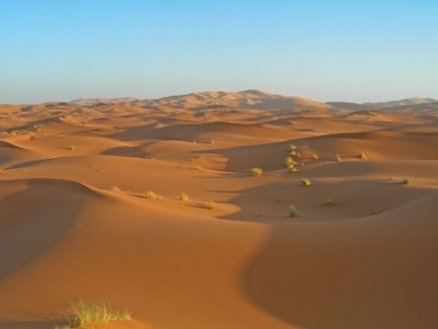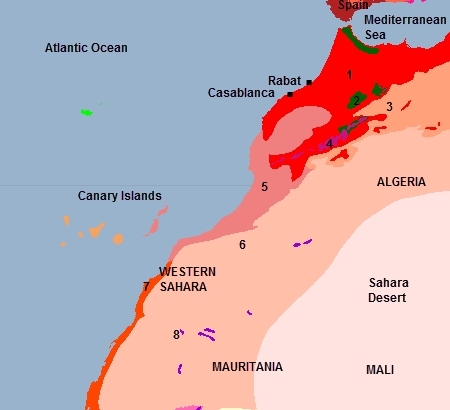Morocco
Countries and Regions of the World Collection  Morocco is a nation of over thirty-two million people in northern Africa, bordered by the North Atlantic Ocean and the Mediterranean Sea, between Algeria to the east and Western Sahara.
Morocco is a nation of over thirty-two million people in northern Africa, bordered by the North Atlantic Ocean and the Mediterranean Sea, between Algeria to the east and Western Sahara.
It has a strategic location along the Strait of Gibraltar, the narrow gateway between the Mediterranean Sea and the Atlantic Ocean opposite Spain. Morocco's northern coastand interior are mountainous (Rif Mountains and Atlas mountains) with large areas of bordering plateaus, intermontane valleys, and rich coastal plains.
The south and east of the country is dominated by the Sahara Desert. There are four enclaves on its Mediterranean coast which are administered by Spain, which Morocco contests.It also claims and administers Western Sahara whose sovereignty remains unresolved.
Morocco's major environmental issues include: 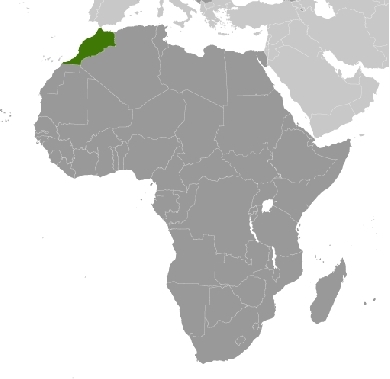
- land degradation/desertification (soil erosion resulting from farming of marginal areas, overgrazing, destruction of vegetation);
- water supplies contaminated by raw sewage;
- siltation of reservoirs; and,
- oil pollution of coastal waters.
Its northern mountains are geologically unstable and subject to seismic events, and the country is quite arid and prone to periodic exceptional droughts.
In 788 AD, about a century after the Arab invasion and conquest of North Africa, successive Moorish dynasties began to rule in Morocco.
In the 16th century, the Sa'adi monarchy, particularly under Ahmad al-Mansur (1578-1603 AD), repelled foreign invaders and inaugurated a golden age. The Alaouite dynasty, to which the current Moroccan royal family belongs, dates from the 17th century.
In 1860, Spain occupied northern Morocco and ushered in a half century of trade rivalry among European powers that saw Morocco's sovereignty steadily erode.
In 1912, the French imposed a protectorate over the country. A protracted independence struggle with France ended successfully in 1956. The internationalized city of Tangier and most Spanish possessions were turned over to the new country that same year.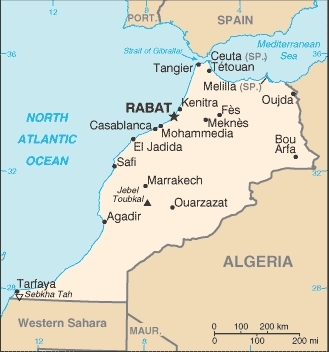
Sultan Mohamed V, the current monarch's grandfather, organized the new state as a constitutional monarchy and in 1957 assumed the title of king.
Morocco annexed Western Sahara during the late 1970s, but final resolution on the status of the territory remains unresolved, with the Moroccan government steadily on guard for incursions of terrorists that reside and train in Western Sahara.
Gradual political reforms in the 1990s resulted in the establishment of a bicameral legislature, which first met in 1997. Under King Mohamed VI - who in 1999 succeeded his father to the throne - human rights have improved. Morocco enjoys a moderately free press, but the government has taken action against journalists who they perceive to be challenging the monarchy,
Islam, and the status of Western Sahara. Influenced by protests elsewhere in the Middle East and North Africa, in February 2011 thousands of Moroccans began weekly rallies in multiple cities across the country to demand greater democracy and a crackdown on government corruption. Police response to most of the protests was subdued compared to the violence elsewhere in the region.
A commission set up in March 2011 presented a draft constitution that was passed by popular referendum in July 2011. Under the new constitution, some new powers were extended to parliament and the prime minister, but ultimate authority remained in the hands of the monarch. That same month, the king urged swift implementation of the new constitution, starting with the holding of parliamentary elections in 2011 instead of in 2012. A prominent moderate Islamist party, the Justice and Development Party, subsequently won the largest number of seats on 25 November 2011, becoming the first Islamist party to lead the Moroccan Government. In January 2012, Morocco assumed a nonpermanent seat on the UN Security Council for the 2012-13 term.
Contents
Geography
Location: Northern Africa, bordering the North Atlantic Ocean and the Mediterranean Sea, between Algeria and Western Sahara
Geographic Coordinates: 32 00 N, 5 00 W
Area: 446,550 km2 (446,300 km2 land and 250 km2 water)
arable land: 19%
permanent crops: 2%
other: 79% (2005)
Land Boundaries: 2,017.9 km. Border countries: Algeria 1,559 km, Western Sahara 443 km, Spain (Ceuta) 6.3 km, Spain (Melilla) 9.6 km
Coastline: 1,835 km
Maritime Claims:
territorial sea: 12 nm
contiguous zone: 24 nm
exclusive economic zone: 200 nm
continental shelf: 200 m depth or to the depth of exploitation
Natural Hazards: northern mountains geologically unstable and subject to earthquakes; periodic droughts
Terrain: Northern coast and interior are mountainous with large areas of bordering plateaus, intermontane valleys, and rich coastal plains. Its lowest point is Sebkha Tah (-55 metres) and its highest point is Jebel Toubkal (4165 metres).
Climate: Mediterranean, becoming more extreme in the interior of the country.
Ecology and Biodiversity
|
1. Mediterranean woodlands and forests 2. Mediterranean conifer and mixed forests 3. Mediterranean dry woodlands and steppe 4. Mediterranean High Atlas juniper steppe 5. Mediterranean acacia-argania dry woodlands and succulent thickets 6. North Saharan steppe and woodlands In Western Sahara, which is claimed by Morocco are also found the following two ecoregions: Map source: World Wildlife Fund See also: |
People and Society
Population: 32,309,239 (July 2012 est.)
Moroccans are predominantly Sunni Muslims of Arab, Berber, or mixed Arab-Berber ancestry. The Arabs brought Islam, along with Arabic language and culture, to the region from the Arabian Peninsula during the Muslim conquests of the 7th century AD. Today, a small Jewish community remains as well as a largely expatriate Christian population; both enjoy religious freedom and full civil rights. Morocco is also home to a 300-500-person Baha’i community which, in recent years, has been able to worship free from government interference.
Arabic is Morocco's official language, but French and English are widely taught and serve as the primary languages of commerce and government. Moroccan colloquial Arabic, Darija, is composed of a unique combination of Arabic, Berber, and French dialects. Along with Arabic, about 10 million Moroccans, predominantly in rural areas, also speak one of the three Moroccan Berber dialects (Tarifit, Tashelhit, and Tamazight). Spanish is also used in the northern part of the country. English is increasingly becoming the foreign language of choice among educated youth and is offered in many public schools from the fourth year on.
Most people live west of the Atlas Mountains, a range that insulates the country from the Sahara Desert. Casablanca is the center of commerce and industry and the leading port; Rabat is the seat of government; Tangier is the gateway to Spain and also a major port; "Arab" Fes is the cultural and religious center; and "Berber" Marrakech is a major tourist center.
Education in Morocco is free and compulsory through primary school (age 15). Nevertheless, many children--particularly girls in rural areas--do not attend school, and most of those who do drop out after elementary school. The country's literacy rate reveals sharp gaps in education, both in terms of gender and location; while country-wide literacy rates are estimated at 39.6% among women and 65.7% among men, the female literacy rate in rural areas is estimated only at 10%.
Morocco is home to 14 public universities. Mohammed V University in Rabat is one of the country’s most famous schools, with faculties of law, sciences, liberal arts, and medicine. Founded over 1,000 years ago, Karaouine University, in Fes, is the oldest center for Islamic studies in the Maghreb. Morocco’s most prestigious private English-language university, Al-Akhawayn, was founded in 1993 by King Hassan II and King Fahd of Saudi Arabia in Ifrane. Its curriculum is based on an American model.
Ethnic groups: Arab-Berber 99%, other 1%
Age Structure:
0-14 years: 27.8% (male 4,514,623/female 4,382,487)
15-64 years: 66.1% (male 10,335,931/female 10,785,380)
65 years and over: 6.1% (male 881,622/female 1,068,318) (2011 est.)
Population Growth Rate: 1.054% (2012 est.)
Birth Rate: 18.97 births/1,000 population (2012 est.)
Death Rate: 4.76 deaths/1,000 population (July 2012 est.)
Net Migration Rate: -3.67 migrant(s)/1,000 population (2012 est.)
Life Expectancy at Birth: 76.11 years
male: 73.04 years
female: 79.32 years (2012 est.)
Total Fertility Rate: 2.19 children born/woman (2012 est.)
Languages: Arabic (official), Berber dialects, French often the language of business, government, and diplomacy
Literacy(2004 census): 52.3% (male: 65.7% - female: 39.6%)
Urbanization: 58% of total population (2010) growing at a 2.1% annual rate of change (2010-15 est.)
History
 Marrakech architectural feature.
Marrakech architectural feature.
Source: C.Michael Hogan Morocco's strategic location has shaped its history.
The northern portion of Morocco was known as Mauritania in ancient times, when the first recorded history was that of Phoenician conquest of indigenous tribes to establish strategic military and economic outposts at locations such as Volubilis, Lexus, Chellah and Mogador. Later rule was held by the Carthagineans, who were also a seafaring power; however, Carthage's control was superceded by the ambitions of Rome, who conquered the region and rebuilt major cities such as Chellah and Volubilis in the Roman model.
Beginning with the Phoenicians, many foreigners were drawn to this area. Romans, Visigoths, Vandals and Byzantine Greeks ruled successively. Arab forces began occupying Morocco in the 7th century A.D., bringing their civilization and Islam. The Alaouite dynasty, which has ruled Morocco since 1649, claims descent from the Prophet Muhammad.
Morocco's location and resources led to early competition among European powers in Africa, beginning with successful Portuguese efforts to control the Atlantic coast in the 15th century. France showed a strong interest in Morocco as early as 1830. Following recognition by the United Kingdom in 1904 of France's "sphere of influence" in Morocco, the Algeciras Conference (1906) formalized France's "special position" and entrusted policing of Morocco to France and Spain jointly. The Treaty of Fes (1912) made Morocco a protectorate of France. By the same treaty, Spain assumed the role of protecting power over the northern and southern (Saharan) zones. 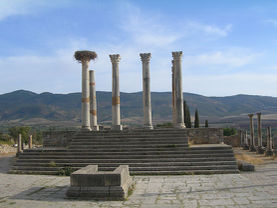 Volubilis ruins, Morocco. Soruce: C.Michael Hogan
Volubilis ruins, Morocco. Soruce: C.Michael Hogan
Nationalist political parties, which took shape under the French protectorate, began a strong campaign for independence after World War II. Declarations such as the Atlantic Charter (a joint U.S.-British statement set forth, among other things, the right of all people to choose the form of government under which they live), served as a base for the independence movement. A manifesto of the Istiqlal (Independence) Party in 1944 was one of the earliest public demands for independence. That party subsequently provided most of the leadership for the nationalist movement and remains a strong political party.
In 1953, France exiled the highly respected Sultan Mohammed V and replaced him with the unpopular Mohammed Ben Aarafa. Ben Aarafa’s reign was widely perceived as illegitimate, and sparked active opposition to French rule. France allowed Mohammed V to return in 1955, and Morocco gained independence on March 2, 1956. In 2006, Moroccans celebrated their 50th year of independence from France.
Morocco regained control over certain Spanish-ruled areas through agreements with Spain in 1956 and 1958. The internationalized city of Tangier was reintegrated into Morocco with the signing of the Tangier Protocol on October 29, 1956. The Spanish enclave of Ifni in the south became part of Morocco in 1969. Spain, however, retains control over the small coastal enclaves of Ceuta and Melilla in the north.
Hassan II became king in 1961. During the 1990s, King Hassan made great strides toward economic and political liberalization. He died on July 23, 1999, and was succeeded by his son, Mohammed VI, who pledged to continue the reforms.
Western Sahara
For nearly 40 years, Morocco and the independence-seeking Polisario have vied for control of the Western Sahara, a former Spanish territory. Morocco's claim to sovereignty over the Western Sahara is based largely on a historical argument of traditional loyalty of Sahrawi tribal leaders to the Moroccan sultan. The Polisario claims to represent the aspirations of the inhabitants of Western Sahara for independence.
From 1904 until 1975, Spain occupied the entire territory, which is divided into a northern portion, the Saguia el Hamra, and a southern two-thirds, the Rio de Oro. In 1969, the Polisario Front was formed to combat the occupation of the territory. In November 1975, King Hassan mobilized 350,000 unarmed Moroccan citizens in what came to be known as the “Green March” into Western Sahara. The march was designed to both demonstrate and strengthen Moroccan claims to the territory, and it is celebrated to this day. On November 14, Spain, Morocco, and Mauritania announced a tripartite agreement for an interim administration under which Spain agreed to share administrative authority with Morocco and Mauritania, leaving aside the question of sovereignty. With the establishment of a Moroccan and Mauritanian presence throughout the territory, however, Spain's role in the administration of the Western Sahara effectively ceased.
After a period of hostilities, Mauritania withdrew from the territory in 1979 and signed a peace treaty with the Polisario, relinquishing all claims to the territory. Moroccan troops occupied the region vacated by Mauritania and later proclaimed the territory reintegrated into Morocco. Morocco subsequently built a fortified berm around three-fourths of Western Sahara and exercises de facto administrative control over 80% of the territory.
At the OAU (now African Union) summit in June 1981, King Hassan announced his willingness to hold a referendum in Western Sahara. Subsequent meetings of an OAU Implementation Committee proposed a cease-fire, a UN peacekeeping force, and an interim administration to assist with an OAU-UN-supervised referendum on the issue of independence or annexation. In 1984, the OAU seated a delegation of the Sahara Arab Democratic Republic (SADR), the shadow government of the Polisario, which provoked Morocco to withdraw from the OAU.
In 1988, Moroccan and Polisario representatives agreed on a joint UN/OAU settlement proposal for a referendum, but, due to disagreements over who could vote and what options of self-determination could be voted on, it never took place. In 1991, the UN brokered a cease-fire and settlement plan and established the United Nations Mission for the Referendum in Western Sahara (known by its French acronym, MINURSO), which deployed a roughly 200-person monitoring force to the territory. Since 1992 the UN Security Council has extended MINURSO's mandate.
The UN continues to explore with the parties ways of arriving at a mutually agreed political settlement and to promote confidence-building measures between the parties in the interim. In 2003, former Secretary of State James Baker, working as UN Secretary General Kofi Annan’s Personal Envoy, put forward a peace plan calling for a referendum on issues of autonomy or integration with Morocco. While the Polisario Front and the Algerian Government accepted the plan, Morocco rejected it. After a 7-year effort to assist the parties in coming to an agreement, James Baker resigned as Personal Envoy in June 2004. In August of the same year, Kofi Annan appointed Alvaro de Soto Special Representative for the Western Sahara to continue Baker’s work. Special Representative de Soto left his position in May 2005 and Peter van Walsum of the Netherlands took his place. Van Walsum oversaw four rounds of talks and retired in August 2008. A retired U.S. diplomat, Ambassador Christopher Ross, was named the Secretary General’s new Western Sahara envoy in January 2009. Ross determined that informal talks and a focus on confidence building measures would be necessary before formal talks could produce meaningful progress. He conducted the first round of informal talks between Morocco and the Polisario in August 2009, with Algeria and Mauritania attending as observers. Since then, Ross held nine additional rounds of informal talks, but progress has been elusive.
The Western Sahara dispute remains the primary impediment to regional integration and development goals and Moroccan-Algerian relations. The parties were able to set aside some of their differences when, in August 2004, U.S. Senator Richard Lugar led a mission to the region that resulted in the release of 404 Moroccan prisoners of war who had long been held by the Polisario. Today, approximately 90,000 Sahrawi refugees live in camps around Tindouf, Algeria. The exact number of refugees living in these camps is not known, since there has never been a reliable census of the population. Several thousand Sahrawis also live in the Moroccan-controlled area of Western Sahara among a large number of Moroccan settlers. Morocco considers the Western Sahara part of its national territory, while the Polisario, with Algerian support, insists on the right of the people of the Western Sahara to self-determination.
The United States has consistently encouraged the parties to work with the United Nations and with each other, in a spirit of flexibility and compromise, to find a mutually acceptable settlement. In this spirit, the U.S. supported UN Security Council resolutions 1871 (2009) and 1813 (2008), which took note of the Moroccan autonomy proposal presented to the Secretary General on April 11, 2007, and welcomed the serious and credible Moroccan efforts to move the process forward toward a settlement. Both unanimously adopted resolutions took note of the Polisario proposal as well, which was presented on April 10, 2007. The U.S. Government fully supports current efforts by the UN Secretary General and Ambassador Ross to find a peaceful, sustainable, and mutually agreed solution on the Western Sahara conflict.
Seven Sahrawi human rights activists returning from a visit to the Polisario camps in Tindouf, Algeria were arrested by Moroccan police in Casablanca on October 8, 2009. The activists, who publicly criticized the government of Morocco and King Mohammed VI in a press conference that aired on Algerian television, were referred to a military court and charged with harming external state security. Four of the activists were released on humanitarian grounds and the remaining three were granted royal pardons in April 2011, though they have not been formally cleared of all charges.
On the 34th anniversary of King Hassan II’s march into Western Sahara, King Mohammed VI outlined a decentralization plan to improve governance and promote political, economic, and cultural integration of “the southern provinces” into Moroccan society. The November 6, 2009 speech stated that when it comes to the Western Sahara, there is no middle ground between patriotism and treason.
On November 14, 2009 Sahrawi activist Aminatou Haidar, arriving on a flight from the Canary Islands, was detained at Laayoune airport in Western Sahara. Moroccan authorities maintained that Haidar initiated a process of renouncing her Moroccan citizenship when she listed “Sahrawi” as her citizenship and the “Territory of Western Sahara” as her country of citizenship on her immigration forms. Moroccan authorities held her passport and returned Haidar to the Canary Islands. Following a 32-day hunger strike that generated widespread international publicity, Morocco readmitted Haidar into Laayoune on December 18, 2009 on humanitarian grounds.
In mid-October 2010, several thousand Sahrawis set up tents on the outskirts of the capital city of Laayoune, in protest of perceived unequal treatment under government policies with regard to the distribution of subsidized housing, jobs, and social benefits. The Government of Morocco dismantled the tent encampment on November 8, 2010, provoking riots in Laayoune and leading to allegations of human rights abuses at the hands of Moroccan security forces by local and international activists, non-governmental organizations (NGOs), and media. Twenty-three Sahrawi detainees from the Laayoune riots remain in custody and are awaiting trial by military court.
Government
Government Type: Constitutional Monarchy
In 2011, Morocco adopted a new constitution with the potential to fundamentally reshape the division of powers between the monarchy and the legislature, to strengthen the independence of the judiciary, and to enhance human rights.
In the wake of widespread protests across Morocco in early 2011, prompted by Arab Spring unrest throughout the region, King Mohammed VI introduced a reform program that included constitutional reforms and early elections. On July 1, voters approved a new constitution that strengthened the role of the parliament and called for an independent judiciary. Dominant authority still rests with the king; the monarch appoints the head of government from the party that wins the most seats in parliamentary elections; appoints all members of the government based on the head of government’s recommendations; and may, at his discretion, terminate the tenure of any minister, dissolve the parliament, call for new elections, or rule by decree. The king is the commander in chief of the military and holds the title of Amir al-Mou’minin, or Commander of the Faithful, the country's religious leader.
The parliament’s powers were expanded under the new constitution in 2011 to include the ability to pass laws on a wide range of issues. However, the king reserves the right to rule on religious issues, security, and major policy decisions. The bicameral legislature, established in 1996, consists of a lower chamber called the Chamber of Representatives, which is directly elected by the voters, and an upper chamber, the Chamber of Counselors, whose members are indirectly elected through various regional, local, and professional councils. The lower chamber of the parliament has the power to dissolve the government through a majority vote of no confidence, though it has never been used.
Parliamentary elections held in November 2011 were generally regarded by international observers as free and fair. However, voter turnout was relatively low, with only 45% of registered voters casting ballots, and independent observers estimate up to 20% of votes cast were invalid or protest ballots. The Islamist Party of Justice and Development (PJD) overwhelmingly won the popular vote, winning 107 seats out of 395 in the parliament. Abdelilah Benkirane, Secretary General of the PJD, was appointed to be the head of government by the king. Benkirane formed a government based on a coalition composed of the PJD, Istiqlal, the Popular Movement (MP), the Constitutional Union (UC), and the Party of Progress and Socialism (PPS).
Under Mohammed VI, the Moroccan Government has undertaken a number of economic, social, and political reforms, including the 2003 Moudawana, a reform of the family status code, and the 2006 Equity and Reconciliation Commission, which investigated allegations of human rights abuse from 1956 to 1999. In 2005, the king launched the National Initiative for Human Development (INDH), a project to address poverty in rural areas and combat social exclusion in urban areas. The government initiated a number of other important reforms, upgrading the national education system, overhauling the health care regime, broadening the scope of medical insurance, and facilitating access to housing to achieve its human development goals.
Capital: Rabat - 1.77 million (2009)
Other major cities: Casablanca 3.245 million; Fes 1.044 million; Marrakech 909,000; Tangier 768,000 (2009)
Administrative Divisions: Morocco is divided into 16 administrative regions (further broken into provinces and prefectures); the regions are administered by walis (governors) appointed by the king. 15 regions; Grand Casablanca, Chaouia-Ouardigha, Doukkala-Abda, Fes-Boulemane, Gharb-Chrarda-Beni Hssen, Guelmim-Es Smara, Laayoune-Boujdour-Sakia El Hamra, Marrakech-Tensift-Al Haouz, Meknes-Tafilalet, Oriental, Rabat-Sale-Zemmour-Zaer, Souss-Massa-Draa, Tadla-Azilal, Tanger-Tetouan, Taza-Al Hoceima-Taounate.
note: Morocco claims the territory of Western Sahara, the political status of which is considered undetermined by the US Government; portions of the regions Guelmim-Es Smara and Laayoune-Boujdour-Sakia El Hamra as claimed by Morocco lie within Western Sahara; Morocco also claims Oued Eddahab-Lagouira, another region that falls entirely within Western Sahara
Independence Date: 2 March 1956 (from France)
Legal System: based on Islamic law and French and Spanish civil law systems; judicial review of legislative acts in Constitutional Chamber of Supreme Court; has not accepted compulsory ICJ jurisdiction
Suffrage: 18 years of age; universal (as of January 2003)
International Environmental Agreements
Morocco is party to international agreements on: Biodiversity, Climate Change, Climate Change-Kyoto Protocol, Desertification, Endangered Species, Hazardous Wastes, Law of the Sea, Marine Dumping, Ozone Layer Protection, Ship Pollution, Wetlands, and Whaling. It has signed, but not ratified an agreement on Environmental Modification.
Water
Total Renewable Water Resources: 29 cu km (2003)
Freshwater Withdrawal: Total: 12.6 cu km/yr (10% domestic, 3% industrial, 87% agricultural).
Per capita Freshwater Withdrawal: 400 cu m/yr (2000).
Access to improved sources of drinking water: 81% of population
Access to improved sanitation facilities: 69% of population
Agriculture
Agricultural Products: barley, wheat, citrus, wine, vegetables, olives; livestock
Irrigated Land: 14,450 sq km (2003)
Resources
Natural Resources: phosphates, iron ore, manganese, lead, zinc, fish, salt.
Energy
| Energy in Morocco | |||||
| Production | Consumption | Exports | Imports | Reserves | |
| Electricity | 19.49 billion kWh (2008 est.) |
21.47 billion kWh (2008 est.) |
0 kWh (2009 est.) |
3.429 billion kWh (2009 est.) |
|
| Oil | 3,938 bbl/day (2010 est.) |
209,000 bbl/day (2010 est.) |
25,090 bbl/day (2009 est.) |
221,000 bbl/day (2009 est.) |
680,000 bbl (1 January 2011 est.) |
| Natural Gas | 60 million cu m (2009 est.) |
560 million cu m (2009 est.) |
0 cu m (2009 est.) |
500 million cu m (2009 est.) |
1.444 billion cu m (1 January 2011 est.) |
| Source: CIA Factbook | |||||
Economy
Morocco has capitalized on its proximity to Europe and relatively low labor costs to build a diverse, open, market-oriented economy. In the 1980s Morocco pursued austerity measures and pro-market reforms, overseen by the IMF.
The Moroccan economy has been characterized by macroeconomic stability, with generally low inflation and sustained, moderately high growth rates over the past several years. Morocco's primary economic challenge is to accelerate growth and sustain that improved performance in order to reduce high levels of unemployment and underemployment. While overall unemployment stood at 9.1% in the third quarter of 2011, this figure masks significantly higher urban unemployment, over 30% among young urban males.
Recent governments have pursued reform, liberalization, and modernization aimed at stimulating growth and creating jobs. Since early in his reign, King Mohammed VI has called for expanded employment opportunities, economic development, meaningful education, and increased housing availability. The government has pursued an ambitious program of reforms to increase productivity and competitiveness of the national economy through sectoral strategies targeting energy, fisheries, industry, commerce, agriculture, tourism, and logistics. The new government appointed in January 2012 is expected to continue these policies. Promising reforms have occurred in the financial sector. Privatizations have reduced the size of the public sector. Morocco has liberalized rules for oil and gas exploration and has granted concessions for public services in major cities. The tender process in Morocco is becoming increasingly transparent. The government has invested considerably in infrastructure development, in particular Tanger-Med Port at the Strait of Gibraltar. When completed in 2014, Tanger-Med will be Africa’s largest port. Many believe, however, that the process of economic reform must be accelerated.
While economic growth has historically been hampered by volatility in the rainfall-dependent agriculture sector, diversification has made the economy more resilient. Despite an unfavorable international economic environment, Morocco’s economy grew by 3.7% in 2010, and was estimated to have grown at a 4.5% rate in 2011. The government projects a growth rate of 5.5% in 2012.
Through a foreign exchange rate pegged to a basket of important currencies and well-managed monetary policy, Morocco has held inflation rates to industrial country levels over the past decade. Inflation fell from 3.9% in 2008 to 1% in 2009, a level it maintained during 2010 and 2011.
Since 2007, Morocco has run a current account deficit, mainly driven by a negative trade balance. The persistent merchandise trade deficit, driven by the country’s need for imported energy, has been largely offset by inflows including transfers from Moroccans resident abroad, tourism revenue, and foreign investment. In 2010, the current account deficit stood at 4.6% of GDP. The International Monetary Fund (IMF) estimated that the current account deficit would double for 2011, to 8.9% of GDP. In March 2010, Standard and Poor's raised Morocco's foreign and local currency ratings by one notch (to BBB- from BB+ and to BBB+ from BBB, respectively) after the country significantly reduced both its internal and external public debt. Foreign exchange reserves and active external debt management policies give Morocco the capacity to service its debt. At the end of 2010, current external debt stood at $20.5 billion. Foreign exchange reserves continued to decline in 2011, totaling less than 6 months' worth of goods and services imports.
In January 2006, In 2006 Morocco entered into a bilateral Free Trade Agreement with the United States; it remains the only African country to have one. The U.S.-Morocco FTA eliminated tariffs on 95% of bilateral trade in consumer and industrial products with all remaining tariffs to be eliminated within 9 years. The negotiations produced a comprehensive agreement covering not only market access, but also intellectual property rights protection, transparency in government procurement, investment, services, and e-commerce. Other chapters spell out consultation and assistance mechanisms in the areas of labor and environmental protection. The FTA provides new trade and investment opportunities for both countries and has encouraged economic reforms and liberalization. Since its entry into force, bilateral trade between the two countries increased 272% through November of 2011.
In 2008 Morocco entered into an Advanced Status agreement with the European Union.
Despite Morocco's economic progress, the country suffers from high unemployment and poverty. In 2011, high food and fuel prices strained the government's budget and widened the country's current account deficit.
Key economic challenges for Morocco include fighting corruption, reducing government spending, reforming the education system and judiciary, addressing socioeconomic disparities, and building more diverse, higher value-added industries.
GDP (Purchasing Power Parity): $163 billion (2011 est.)
GDP (Official Exchange Rate): $101.8 billion (2011 est.)
GDP- per capita: $5,100 (2011 est.)
GDP- composition by sector:
agriculture: 16.6%
industry: 32.3%
services: 51% (2011 est.)
Population Below Poverty Line: 15% (2007)
Industries: phosphate rock mining and processing, food processing, leather goods, textiles, construction, tourism
Economic Aid Recipient: ODA, $651.8 million (2005)
Currency: Moroccan dirham (MAD)
Ports and Terminals: Agadir, Casablanca, Mohammedia, Safi
References
- Jean-Louis Ballais. 2000. "Chapter 7: Conquests and land degradation in the eastern Maghreb" In Barker, Graeme and Gilbertson, David: The Archaeology of Drylands: Living at the Margin. Routledge, London, Volume 1
- C.Michael Hogan. 2007. Volubilis, Megalithic Portal, ed. A. Burnham
